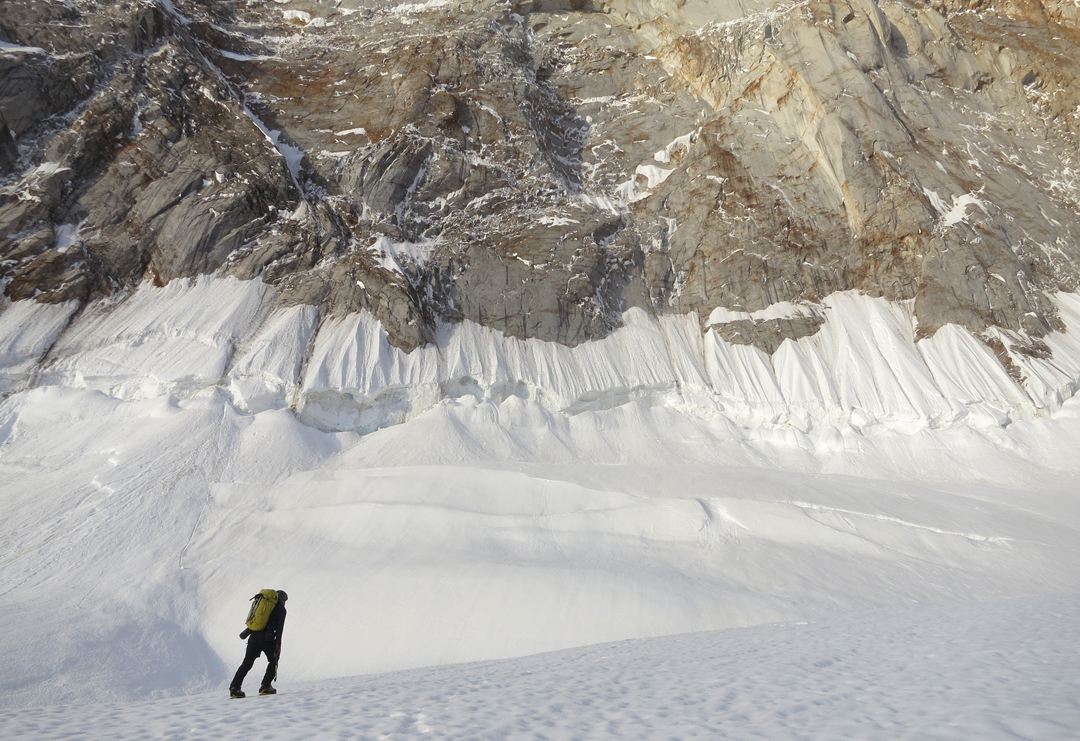Near Miss on Ogre II
Pakistan, Karakoram, Panmah Muztagh
 Scott Adamson and I arrived at Choktoi base camp on July 4 with permits for Ogre II and Latok I. This was my sixth expedition to Pakistan, and it was by far the warmest Karakoram season I have experienced. As Scott and I acclimated during the first two weeks of July, we climbed and traveled on the glacier solely through the hours of midnight to 10 a.m. Extreme temperatures forced us to stop during the day as we watched the mountains disintegrate.
Scott Adamson and I arrived at Choktoi base camp on July 4 with permits for Ogre II and Latok I. This was my sixth expedition to Pakistan, and it was by far the warmest Karakoram season I have experienced. As Scott and I acclimated during the first two weeks of July, we climbed and traveled on the glacier solely through the hours of midnight to 10 a.m. Extreme temperatures forced us to stop during the day as we watched the mountains disintegrate.
On July 18 we woke at 1 a.m. and left advanced base to begin our attempt on the unclimbed 1,400m north face of Ogre II. We carried a stove, two-person sleeping bag, a tarp, six ice screws, a single set of cams, nuts, six pins, and two 60m, 7.3mm ropess. We were able to move quickly on the lower part of the mountain, climbing past short mixed bulges with good gear, and connecting snow and ice systems. Increasing cloud cover (as forecast) and cooler temperatures higher on the face contributed to minimal rockfall.
At 9 p.m., under light snow, we arrived at a 60° band of snow and ice ridges, where we hoped to bivouac. The bulletproof ice allowed for excavation of a ledge 50cm deep, and Scott and I pulled the two-person sleeping bag over our heads and sat shoulder to shoulder for the evening. At dawn light spindrift filled our sleeping bag. Unable to sleep, Scott rappelled a full pitch and found a better place to dig into the ice. We made a ledge large enough for us to lie nearly flat, wrapped ourselves in the tarp, and dozed off.
At 1 p.m. we decided to climb toward the summit ridge, which likely held a decent bivouac site. I led a delicate 150m leftward traverse and climbed up and into a massive dihedral that pointed us toward the ridge. Two more elegantly steep and technical pitches, the crux of the face, put us just below a short overhanging section. It was dark when Scott arrived at the anchor and I passed him the rack. I remember looking at his watch and seeing 6,613m, indicating how close we were to the 6,980m summit. He climbed past the overhang, into the low-angle corner, and out of sight. The rope began moving faster and I felt relieved, thinking he had found easier ground. Several minutes later I heard him yell. Assuming this meant “Rock!,” I swung close to the wall on the hanging belay. Suddenly: sparks, a headlamp, and Scott came flying past. “Holy shit! Are you okay?” I yelled. He had come to a stop more than 15m below me. I could see his headlamp slowly scanning his surroundings, and I gave him a minute. “Well, I think my leg is broken,” was his response.

Before starting down, we had to cut nearly 12m from one of our ropes because of damage from the fall. It was hard for Scott to rappel at an angle, so I tried to build anchors directly down the fall line. After only three rappels, the sheath peeled down the rope we’d already cut, exposing another long section of core. We continued down, watching our rack diminish. After we rappelled over a 6m horizontal roof, the second rope became completely stuck and I had to cut about 33m from it. On subsequent rappels I remember thinking both ropes now seemed to be about 30m.
What had been swirling snowflakes was now a torrent of spindrift down the snow-covered granite slab. With only three cams remaining, I urgently searched for V-threads. At first light, around 4:30 a.m., Scott and I could see the glacier below; we had perhaps three or four short rappels to go. For the next anchor, I settled on a small patch of marginal ice that was covered in fresh snow. I built the anchor and clipped in. Scott rappelled down and also clipped to the anchor. There was no backup. We pulled the ropes and I began rappelling. Four meters below, as I went over a small bulge, the V-thread popped and we both fell 90m to the glacier. Scott had no additional injuries; I had only a bloody nose.
For weeks and months after our accident I beat myself up over my mistake and the complacency that nearly killed both of us. As I ponder the difficult events and situational conditions leading up to the anchor failure, I view them as both important to analyze and also as potential excuses for the inexcusable. Anchors can’t fail. Every single one, no matter how tired you are or how bad conditions become, needs to be placed in a state of complete mental and physical awareness. With deliberate attention and over-emphasized inspection, you need to see and feel that the anchor is solid, and then place a backup piece for the first (heavier) person rappelling.
Scott and I are both recovering well from our summer expedition and excited to get back at it when the time feels right. We’d like to thank the Mugs Stump Award and AAC’s Lyman Spitzer Grant for encouraging, supporting, and funding climbers to pursue their dreams, and sometimes their hardships, in the mountains. It is with each experience that, as a community, we grow.
Summary: Attempt on the north face of Baintha Brakk II (Ogre II, 6,980m) to ca 6,600m, by Scott Adamson and Kyle Dempster (USA).







